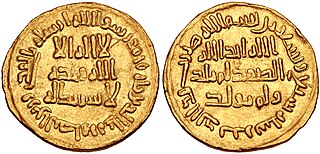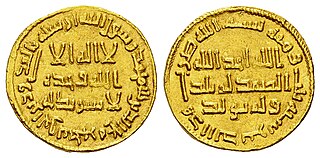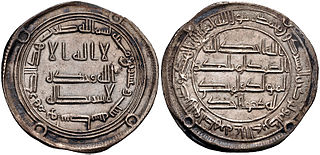The 740s decade ran from January 1, 740, to December 31, 749.
The 700s decade ran from January 1, 700, to December 31, 709.

Year 701 (DCCI) was a common year starting on Saturday of the Julian calendar, the 701st year of the Common Era (CE) and Anno Domini (AD) designations, the 701st year of the 1st millennium, the 1st year of the 8th century, and the 2nd year of the 700s decade. The denomination 701 for this year has been used since the early medieval period, when the Anno Domini calendar era became the prevalent method in Europe for naming years.

The Umayyad Caliphate or Umayyad Empire was the second caliphate established after the death of the Islamic prophet Muhammad and was ruled by the Umayyad dynasty. Uthman ibn Affan, the third of the Rashidun caliphs, was also a member of the clan. The family established dynastic, hereditary rule with Mu'awiya I, the long-time governor of Greater Syria, who became caliph after the end of the First Fitna in 661. After Mu'awiya's death in 680, conflicts over the succession resulted in the Second Fitna, and power eventually fell to Marwan I, from another branch of the clan. Syria remained the Umayyads' main power base thereafter, with Damascus as their capital.

Abu al-Abbas Abd Allah ibn Muhammad ibn Ali ibn Abd Allah, known by his laqab al-Saffah, was the first caliph of the Abbasid Caliphate, one of the longest and most important caliphates in Islamic history.

Sulayman ibn Abd al-Malik ibn Marwan was the seventh Umayyad caliph, ruling from 715 until his death. He was the son of Caliph Abd al-Malik ibn Marwan (r. 685–705) and Wallada bint al-Abbas. He began his career as governor of Palestine, while his father Abd al-Malik and brother al-Walid I reigned as caliphs. There, the theologian Raja ibn Haywa al-Kindi mentored him, and he forged close ties with Yazid ibn al-Muhallab, a major opponent of al-Hajjaj ibn Yusuf, al-Walid's powerful viceroy of Iraq and the eastern Caliphate. Sulayman resented al-Hajjaj's influence over his brother. As governor, Sulayman founded the city of Ramla and built the White Mosque in it. The new city superseded Lydda as the district capital of Palestine. Lydda was at least partly destroyed and its inhabitants may have been forcibly relocated to Ramla, which developed into an economic hub, became home to many Muslim scholars, and remained the commercial and administrative center of Palestine until the 11th century.

Yazid ibn Abd al-Malik ibn Marwan, commonly known as Yazid II, was the ninth Umayyad caliph, ruling from 720 until his death in 724. Although he lacked administrative or military experience, he derived prestige from his lineage, being a descendant of both ruling branches of the Umayyad dynasty, the Sufyanids who founded the Umayyad Caliphate in 661 and the Marwanids who succeeded them in 684. He was designated by his half-brother, Caliph Sulayman ibn Abd al-Malik, as second-in-line to the succession after their cousin Umar, as a compromise with the sons of Abd al-Malik.
Hisham ibn Abd al-Malik ibn Marwan was the tenth Umayyad caliph, ruling from 724 until his death in 743.

Al-Walid ibn Yazid ibn Abd al-Malik, commonly known as al-Walid II, was the eleventh Umayyad caliph, ruling from 743 until his assassination in 744. He succeeded his uncle, Hisham ibn Abd al-Malik.

Yazid ibn al-Walid ibn Abd al-Malik, commonly known as Yazid III, was the twelfth Umayyad caliph, ruling from 744 until his death months later.

Marwan ibn Muhammad ibn Marwan, commonly known as Marwan II, was the fourteenth and last caliph of the Umayyad Caliphate, ruling from 744 until his death. His reign was dominated by a civil war, and he was the last Umayyad ruler to rule the united Caliphate before the Abbasid Revolution toppled the Umayyad dynasty.
Maslama ibn Abd al-Malik was an Umayyad prince and one of the most prominent Arab generals of the early decades of the 8th century, leading several campaigns against the Byzantine Empire and the Khazar Khaganate. He achieved great fame especially for leading the second and last Arab siege of the Byzantine capital Constantinople.

Jund Ḥimṣ was one of the military districts of the caliphal province of Syria.
al-ʿAbbās ibn al-Walīd ibn ʿAbd al-Malik was an Umayyad prince and general, the eldest son of Caliph al-Walid I. He distinguished himself as a military leader in the Byzantine–Arab Wars of the early 8th century, especially in the Siege of Tyana in 707–708, and was often a partner of his uncle Maslama ibn Abd al-Malik during these campaigns. He or his father are credited for founding the short-lived city of Anjar in modern Lebanon.
The Qays–Yaman rivalry refers to the historical rivalries and feuds between the northern Arabian Qays tribes and the southern Arabian Yaman tribes. The conflict emerged among the tribes within the Umayyad Caliphate's army and administration in the 7th and 8th centuries. Membership in either faction was rooted in real or, more likely, perceived genealogical origins of the tribes, which divided them into south Arabian descendants of Qahtan (Yaman) or north Arabian descendants of Adnan (Qays).
The Umayyad dynasty or Umayyads was an Arab clan within the Quraysh tribe who were the ruling family of the Caliphate between 661 and 750 and later of al-Andalus between 756 and 1031. In the pre-Islamic period, they were a prominent clan of the Meccan tribe of Quraysh, descended from Umayya ibn Abd Shams. Despite staunch opposition to the Islamic prophet Muhammad, the Umayyads embraced Islam before the latter's death in 632. Uthman, an early companion of Muhammad from the Umayyad clan, was the third Rashidun caliph, ruling in 644–656, while other members held various governorships. One of these governors, Mu'awiya I of Syria, opposed Caliph Ali in the First Muslim Civil War (656–661) and afterward founded the Umayyad Caliphate with its capital in Damascus. This marked the beginning of the Umayyad dynasty, the first hereditary dynasty in the history of Islam, and the only one to rule over the entire Islamic world of its time.
Sa'id ibn Abd al-Malik ibn Marwan, also known as Saʿīd al-Khayr, was an Umayyad prince and governor.
Maslama ibn Hisham ibn Abd al-Malik, also known by his kunyaAbu Shakir, was an Umayyad prince and commander.
Saʿīd ibn Hishām ibn ʿAbd al-Malik was an Umayyad prince and commander who participated in the Arab–Byzantine wars and the Third Muslim Civil War, often in association with his brother, Sulayman ibn Hisham. For revolting against Caliph Marwan II, he was imprisoned in 746, and he died trying to escape.














